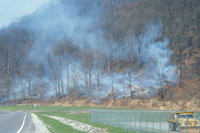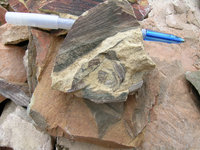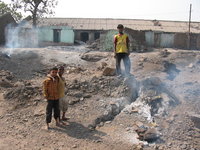Natural and anthropogenic coal fires
Contents
- 1 Abstract
- 2 Introduction Although stratigraphic evidence for prehistoric coal fires (Natural and anthropogenic coal fires) is preserved in the geologic record, the number, frequency, and geographic distribution of such fires has risen dramatically since the industrial revolution in Europe. Subsequent to this event, the demand for a cost-effective fuel necessary to stoke the furnaces of industrialized and developing nations dramatically increased world-wide. As a consequence of this and the increase in the number of coal mines, coal fires and their effects have proliferated. The purpose of this paper is to record and illustrate the effects of some coal fires after first discussing their origin. Such fires as discussed here are those ignited by natural processes or intentionally (arson) or unintentionally by humans, all with generally undesirable consequences.
- 3 Origin of Coal Fires
- 4 Geomorphic and Thermochemical Effects
- 5 Environmental Effects
- 6 Human-Health Effects
- 7 Discussion
- 8 Further Reading
Abstract
The global distribution and occurrence of coal fires has risen since the industrial revolution in Europe due to the rapid growth of coal mining. These fires are a major problem faced by the coal-mining industry. As they burn both on the surface and underground, the fires consume a valuable, non-renewable energy resource. Coal fires are caused by spontaneous combustion, lightning strikes, ground vegetation and refuse fires, and mining and other human-related activities.
Thermochemical transformations from coal fires result in the formation of pyrometamorphic rocks, paralavas, mineral deposits, and creosote (coal tar). These transformations are infrequently documented in the literature, poorly understood, or completely unknown. Examples include creosote and sulfur nucleated from coal-fire gas at the Ruth Mullins fire, eastern Kentucky; minerals nucleated from the gas in the Witbank coalfield, South Africa; and porcelain-like rocks formed when sandstone was baked by burning coal in the Kuznetsk coal basin, Russia.
The geomorphic effects of coal fires include land subsidence, surface cracks, faults, and other geologic structures. Examples of uncontrolled land subsidence occur in the Emery coalfield, Utah; the Jharia coalfield, India; and the Ningxia coalfield, China.
Coal fires are destructive and frequently difficult or cost-prohibitive to extinguish, with some burning for decades and others for hundreds of years. Their environmental effects include pollution (Pollution: forestry and mining operations) of the biosphere, hydrosphere, atmosphere, and lithosphere with toxins, and they often leave a landscape devoid of vegetation and uninhabitable. They are a threat to structures built by people and can be responsible for human diseases including carbon monoxide poisoning, stroke, lung cancer, bronchitis, pulmonary heart disease, chronic obstructive pulmonary disease, arsenosis, and fluorosis. Examples of destruction include 4856 ha (~12 000 acres) of forest land consumed by the 2002 Coal Seam Fire at the South Cañon Number 1 Coal Mine in Colorado; the Ruth Mullins fire that is a respiratory-health hazard and potential threat to Kentucky Route 80; the Laura Campbell fire in Kentucky that could affect the public water supply; the Mulga gob fire in Alabama, also a respiratory-health hazard and responsible for traffic accidents; and the Jharia coalfield fire in India, responsible for asthma, chronic bronchitis, and lung and skin cancer.
In recent years, public awareness about these fires has risen because of symposia held at international-scientific meetings; newspaper, magazine, and journal articles; and coverage by the media. The Elsevier Earth and Environmental Sciences World Atlas of Coal Fires and Combustion Metamorphism will approach coal fires from an interdisciplinary perspective and in so doing, increase public awareness even more about these fires.
Introduction Although stratigraphic evidence for prehistoric coal fires (Natural and anthropogenic coal fires) is preserved in the geologic record, the number, frequency, and geographic distribution of such fires has risen dramatically since the industrial revolution in Europe. Subsequent to this event, the demand for a cost-effective fuel necessary to stoke the furnaces of industrialized and developing nations dramatically increased world-wide. As a consequence of this and the increase in the number of coal mines, coal fires and their effects have proliferated. The purpose of this paper is to record and illustrate the effects of some coal fires after first discussing their origin. Such fires as discussed here are those ignited by natural processes or intentionally (arson) or unintentionally by humans, all with generally undesirable consequences.
Origin of Coal Fires
The origin of coal fires is well documented in the literature. These include both anthropogenic and non-anthropogenic causes such as: (1) spontaneous combustion in response to exothermic-oxidation reactions typically involving sulfide minerals such as pyrite, or gaseous compounds such as hydrogen or methane in the coal; (2) ignition of coal by the spontaneous combustion of oil-soaked rags, lumber, hay, manure, or other combustible materials in culm banks; (3) arson; (4) lightning strikes; (5) forest, grass, or brush fires (Fig. 1) or refuse fires transmitted to coal seams, culm banks, and coal-storage facilities; (6) mining-related activities including welding, electrical work, the detonation of explosives, and short circuiting during mine flooding; and (7) human negligence such as smoking or not dowsing a small fire intentionally started for heating or other purposes, all of which may ignite mine gases such as hydrogen and methane.
Geomorphic and Thermochemical Effects
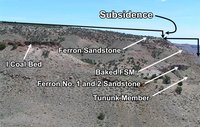 Figure 2. Baked Ferron Sandstone Member of the Cretaceous Mancos Shale in a mesa, looking S15oE across Quitchupah Canyon, Emery Coalfield, Utah. The Tununk Member of the Mancos Shale is exposed at the base of the mesa. Note the partially burned I coalbed exposed in the side of the mesa. Subsidence occurred because of volume reduction from burnt-out coal beds. Coal fires are thought to have played a major role in the development of topographic features in the American west. (Janet L. Stracher, 2005)
Figure 2. Baked Ferron Sandstone Member of the Cretaceous Mancos Shale in a mesa, looking S15oE across Quitchupah Canyon, Emery Coalfield, Utah. The Tununk Member of the Mancos Shale is exposed at the base of the mesa. Note the partially burned I coalbed exposed in the side of the mesa. Subsidence occurred because of volume reduction from burnt-out coal beds. Coal fires are thought to have played a major role in the development of topographic features in the American west. (Janet L. Stracher, 2005) Coal fires like earthquakes, volcanoes, and other forces of nature transform landscapes, generating subsidence basins, surface cracks, faults, and other geologic structures. Spectacular examples of uncontrolled land subsidence can be seen in the Emery coalfield, Utah (Fig. 2); the Jharia coalfield, India; and the Ningxia coalfield, China. The heat energy transfer and gaseous compounds released during a fire generate pyrometamorphic rocks, paralavas, mineral deposits, and creosote (coal tar) formed in response to thermochemical transformations that are infrequently documented in the literature, poorly understood, or completely unknown. One example includes creosote formed at the Ruth Mullins fire in eastern Kentucky where the Hazard No. 7 coalbed in the Pennsylvanian Breathitt Formation is on fire, ignited by a forest fire in 2006 (Fig. 3).
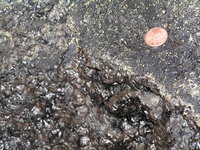 Figure 3. Solid by-products of combustion at the Ruth Mullins Fire near the town of Bulan, eastern Kentucky. The creosote (coal tar) nucleated on sandstone (not visible) from coal-fire gas that cooled after it was exhaled from adjacent vents at the surface. The tar is primarily comprised of polycyclic aromatic hydrocarbons (PAH). The yellow and white minerals on the tar are sulfur (yellow) and salammoniac (NH4Cl), identified by X-ray diffraction; also formed as the gas cooled. Note the small yellow-white deposits of sulfur and salammoniac around the coin. (Sarah M. Mardon and Janet L. Stracher, 2007)
Figure 3. Solid by-products of combustion at the Ruth Mullins Fire near the town of Bulan, eastern Kentucky. The creosote (coal tar) nucleated on sandstone (not visible) from coal-fire gas that cooled after it was exhaled from adjacent vents at the surface. The tar is primarily comprised of polycyclic aromatic hydrocarbons (PAH). The yellow and white minerals on the tar are sulfur (yellow) and salammoniac (NH4Cl), identified by X-ray diffraction; also formed as the gas cooled. Note the small yellow-white deposits of sulfur and salammoniac around the coin. (Sarah M. Mardon and Janet L. Stracher, 2007) Another is the Witbank coalfield of South Africa where beautiful minerals are nucleating from gas vents in burning culm banks (Fig. 4). Such minerals often nucleate by processes more complex than simple condensation form a cooling gas and may be the end product of vent gas reacting with the adjacent substrate upon which the mineral formed in addition to dehydration, boiling, eutectic, and other processes. Yet another example includes porcelain-like sandstone, with its beautifully preserved impressions of Permian plants, baked from burning coal in the Kuznetsk coal basin, Russia (Fig. 5). Coal fires often render a landscape devoid of vegetation and uninhabitable due to the threat of unpredictable subsidence and the possibility of renewed burning.
Environmental Effects
The transformations described above might be considered constructive, for example, by the formation of a subsidence basin or mineral assemblage. However, most people would consider coal fires to be destructive. They are frequently difficult or cost-prohibitive to extinguish and are thus permitted to burn. Many have proven to be persistent, burning for decades or even hundreds of years; refusing to succumb to multiple plans for extinguishment. Some such fires are themselves responsible for generating other types of fires. For example, the subsurface South Cañon Number 1 Coal Mine fire, burning since 1910 just west of Glenwood Springs, Colorado (Fig. 6), ignited the 2002 “Coal Seam Fire” that burned over 4856 ha (~12 000 acres) and destroyed numerous buildings in and around Glenwood Springs. The origin of the South Cañon Mine fire in 1910 may have been spontaneous combustion, but this has never been confirmed.
Coal fires have detrimental effects on the environment and structures built by people. They pollute the biosphere, hydrosphere, atmosphere, and lithosphere with the toxic by-products of combustion. In situ measurements in the field and gas chromatographic analyses reveal that, during burning, these fires spew carbon monoxide, benzene, toluene, and dozens of other toxins into the atmosphere and soil; along with the greenhouse gases methane (during heating of the coal) and carbon dioxide; and the ozone-forming gases ethene, ethane, propene, and propane.
The creosote in coal beds and nucleated from coal-fire gas exhaled from ground vents and fissures contains percent concentrations of polycyclic aromatic hydrocarbons (PAHs) that leach into ground- and surface water, poisoning the surficial ecosystem. The environmental impacts are directly analogous to industrial-coal-tar plants regulated by the USEPA Superfund and numerous state-environmental programs.
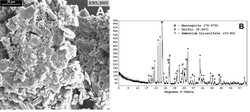 Figure 4. Solid phases found encrusting a gas vent in the Witbank coalfield of South Africa: (A) SEM image of sample KW3 and (B) X-ray diffractogram of this sample. Strong peaks of the phases mascagnite (NH4)2SO4, sulfur, and ammonium thiosulfate (NH4)2S2O3 are labeled. Parenthetical numbers in the inset are the Powder Diffraction Files (International Centre for Diffraction Data, Swarthmore, PA) that best fit the d-spacings and intensities in the pattern. Sample was powdered and scanned at 0.5° 2θ per minute using cobalt Kα radiation. Vertical scale is in counts per second (CPS). Minerals nucleated at coal-fire gas vents are known to contain trace amounts of toxins such as arsenic, mercury, and lead in addition to copper and zinc. (John McCormack (A), 2004 and Paul Schroeder (B), 2004)
Figure 4. Solid phases found encrusting a gas vent in the Witbank coalfield of South Africa: (A) SEM image of sample KW3 and (B) X-ray diffractogram of this sample. Strong peaks of the phases mascagnite (NH4)2SO4, sulfur, and ammonium thiosulfate (NH4)2S2O3 are labeled. Parenthetical numbers in the inset are the Powder Diffraction Files (International Centre for Diffraction Data, Swarthmore, PA) that best fit the d-spacings and intensities in the pattern. Sample was powdered and scanned at 0.5° 2θ per minute using cobalt Kα radiation. Vertical scale is in counts per second (CPS). Minerals nucleated at coal-fire gas vents are known to contain trace amounts of toxins such as arsenic, mercury, and lead in addition to copper and zinc. (John McCormack (A), 2004 and Paul Schroeder (B), 2004) The elements arsenic, fluorine, mercury, and selenium commonly occur in coal. As coal burns, these elements may volatilize and eventually condense in toxic concentrations on dust particles inhaled by humans and livestock or be adsorbed on or by food crops and bio-accumulated in fish, birds, and other animals.
Smoke from the Ruth Mullins fire is a respiratory-health hazard to families living nearby. In addition, the fire could damage Kentucky Route 80, leading to dangerous subsidence if coal was not removed from abandoned mining tunnels beneath the road during construction in 1980. Nearby, the Laura Campbell fire west of Hazard, Kentucky is thought to have started by spontaneous combustion. This fire could destabilize a nearby water tank, affecting the public water supply. Gas analyses from both fires revealed the presence of 47 compounds including those listed above, all emitted from vents with gas temperatures several cm inside that varied from 165-385oC. Surficial deposits include creosote, sulfur, and ammonia compounds, all potential soil and water pollutants (Fig. 3).
At the Mulga Gob Fire in a valley about 24 km (15 mi) northwest of Birmingham, Alabama, a coal fire that started about 20 years ago and was presumably extinguished, re-ignited in 2006, possibly due to spontaneous combustion (Fig. 7). Mulga gob piles contain shale waste rock and chunks of coal from the underground mining of the Pennsylvanian Pottsville Formation prior to the 1970s. Gas from the Mulga Gob Fire can be smelled for several miles and is responsible for respiratory complaints by people living nearby. Local streams affected by the fire have a pH of 2-3. Since the fire reignited, the number of traffic accidents in the valley has increased during the early morning hours when fog and coal-fire gas mix, reducing visibility.
Human-Health Effects
Although the global-annual emissions of the components in coal-fire gas have never been quantified, the toxins from fires burning around the world have made people sick, sometimes culminating in death. From the United States to Asia, documented illnesses include carbon monoxide poisoning, stroke, lung cancer, bronchitis, pulmonary heart disease, chronic obstructive pulmonary disease, arsenosis, and fluorosis. Toxic gas and particulate matter released during burning may be transported long distances. Pollutants from China’s coalfields for example, have contributed to acid rain in the Philippines, Japan, and Korea.
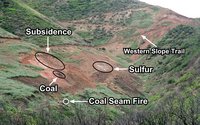 Figure 6. Burning since 1910, the origin of the underground fire in the South Cañon Number 1 Coal Mine west of Glenwood Springs, Colorado, is unknown. On the western slope of the canyon, surface features of the fire include subsidence, burnt vegetation, gas vents (often encrusted with minerals), sulfur, ash, and red-oxidized shale. The 2002 Coal Seam Fire that burned 4856 ha (12,000 acres) started from a gas vent located within the white circle in the photo. (Janet L. Stracher, 2004)
Figure 6. Burning since 1910, the origin of the underground fire in the South Cañon Number 1 Coal Mine west of Glenwood Springs, Colorado, is unknown. On the western slope of the canyon, surface features of the fire include subsidence, burnt vegetation, gas vents (often encrusted with minerals), sulfur, ash, and red-oxidized shale. The 2002 Coal Seam Fire that burned 4856 ha (12,000 acres) started from a gas vent located within the white circle in the photo. (Janet L. Stracher, 2004) An extreme example is the Jharia coalfield where as many as 68 fires burn, some with flames as high as 20 m (66 ft) in an area of 45 km2 (~17 mi2), making this coalfield one of the densest assemblages of coal fires in the world. Here, toxic fly ash and vapors that pollute water, soil, and air promote human diseases including asthma and chronic bronchitis as well as lung and skin cancer. Poor miners and their families are tied to the coalfield because alternative means of sustenance are difficult or impossible to find. These miners live in villages affected by fire, Kúli Dhaóri or miner’s slums, engulfed in toxic vapors (Fig. 8). The walls of their dwellings are often cracked because of fire-induced ground subsidence.
Discussion
Coal fires are one of the biggest problems faced by the coal-mining industry. As these fires burn on the surface and underground, they consume millions of tons of a non-renewable energy resource. In recent years, the public and international-scientific communities have been informed about these fires from Geological Society of America, American Association for the Advancement of Science, and Fossil Fuel Foundation of Africa symposia in addition to newspaper and magazine articles, radio talk shows and movies, and articles published in scientific journals.
In order to increase public awareness about coal fires, Glenn B. Stracher and Anupma Prakash in collaboration with Ellina V. Sokol of the Russian Academy of Sciences, Novosibirsk have undertaken the task of documenting, tracking, and disseminating worldwide information about them. This data base will be included in the Elsevier Earth and Environmental Sciences World Atlas of Coal Fires and Combustion Metamorphism that the authors are preparing. The atlas will approach coal fires from an interdisciplinary perspective and is divided into four parts: coal and coal fires, combustion case studies, photos of coal fires, and multi-media presentations. It will be published in full color in both print and in digital form, available sometime around the later part of 2010. The digital version will include a periodically updated, interactive-world map of coal fires.
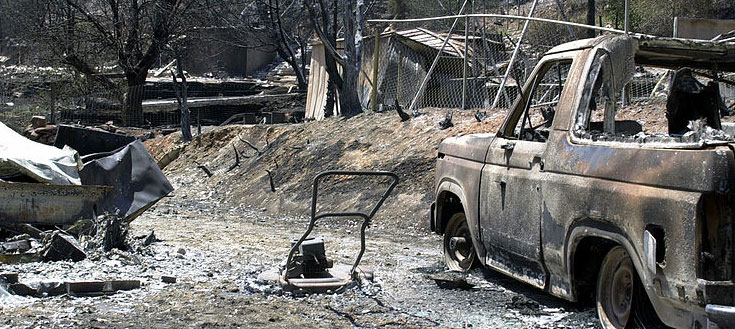 Content Source: Wikimedia Commons (Public Domain Image)
Content Source: Wikimedia Commons (Public Domain Image)
Further Reading
- Bharat Coking Coal Limited, 2009, Brief History of BCCL: http://bccl.cmpdi.co.in/f/FAbtUs.htm
- Finkelman, R.B., 2004, Potential health impacts of burning coal beds and waste banks in Stracher, G.B., ed., Coal Fires Burning around the World: A Global Catastrophe: International Journal of Coal Geology, v. 59, Issues 1-2, p. 19-24.
- Finkelman, R.B., Orem, W., Castranova, V., Tatu, C.A., Belkin, H.E., Zheng, B., Lerch, H.E., Marharaj, S.V., and Bates, A.L., 2002, Health impacts of coal and coal use: Possible solutions: International Journal of Coal Geology, v. 50, p. 425–443.
- Heffern, E.L., Reiners, P.W., Naeser, C.W., and Coates, D.A., 2007, Geochronology of clinker and implications for evolution of the Powder River Basin landscape, Wyoming and Montana in Stracher, G.B., ed., Geology of Coal Fires: Case Studies from Around the World: Reviews in Engineering Geology, v. XVIII, p. 155-175.
- Keefer, R. F. and Sajwan, K. S. eds., 1993, Trace elements in coal and coal combustion residues: Boca Raton, Florida, Lewis Press, 308 p.
- Kroonenberg, S.B. and Zhang, X., 1997, Pleistocene coal fires in northwestern China; Energy for early man, in van Hinte, J.E., ed., One million years of anthropogenic global environmental change: Proceedings of the ARA Symposium at the Royal Netherlands.
- Pone, J. D.N., Hein, K. A.A., Stracher, G.B., Annegarn, H.J., Finkelman, R.B., Blake, D.R., McCormack J.K, and Schroeder, P., 2007, The Spontaneous Combustion of Coal and Its By-Products in the Witbank and Sasolburg Coalfields of South Africa: International Journal of Coal Geology, v. 72, p. 124-140.
- Prakash, A., Fielding, E.J., Gens, R., Genderen, J.L. van, and Evans, D.L., 2001, Data fusion for investigating land subsidence and coalfire hazards in a coal mining area: International Journal of Remote Sensing, v. 22, no. 6, p. 921-932.
- Prakash, A. and Gupta, R.P., 1998, Land-use mapping and change detection in a coal mining area - a case study of the Jharia Coalfield, India: International Journal of Remote Sensing, v. 19, no. 3, p. 391-410.
- Stracher, G.B., 2007, Coal Fires Burning Around the World: Opportunity for Innovative and Interdisciplinary Research: GSA Today, v. 17, no. 11, p. 36-37.
- Stracher, G.B., 2007, The origin of gas-vent minerals: Isochemical and mass transfer processes, in Stracher, G.B., ed., Geology of Coal Fires: Case Studies from Around the World: Reviews in Engineering Geology, v. XVIII, p. 91-96.
- Stracher, G.B., 2007, Illustrations of coal fires in Stracher, G.B., ed., Geology of Coal Fires: Case Studies from Around the World: Reviews in Engineering Geology, v. XVIII, p. ix-xviii.
- Stracher, G.B., Lindsley-Griffin, N., Griffin, J.R., Renner, S., Schroeder, P., Viellenave, J.H., Masalehdani, M, N.-N., and Kuenzer, C., 2007, Revisiting the South Cañon Number 1 Coal Mine Fire during a Geologic Excursion from Denver to Glenwood Springs, Colorado in Raynolds, R.G., ed., Roaming the Rocky Mountains and Environs: Geological Field Trips, Geological Society of America Field Guide 10, p. 101-110.
- Stracher, G.B., Nolter, M.A., Schroeder, P., McCormack, J., and Vice, D.H., 2006, The Great Centralia Mine Fire: A Natural Laboratory for the Study of Coal-Mine Fires, in Pazzaglia, F.J., ed., Excursions in Geology and History: Field Trips in the Middle Atlantic States: Geological Society of America Field Guide 8, p. 33-45.
- Stracher, G.B., Prakash, A., Schroeder, P., McCormack, J., Zhang, X., Van Dijk, P., and Blake, D., 2005, New mineral occurrences and mineralization processes: Wuda coal-fire gas vents of Inner Mongolia: The American Mineralogist, v. 90, p. 1729–1739.
- Stracher, G.B. and Taylor, T.P., 2004, Coal fires burning out of control around the world: Thermodynamic recipe for environmental catastrophe, in Stracher, G.B., ed., Coal Fires Burning around the World: A Global Catastrophe: International Journal of Coal Geology, v. 59, Issues 1–2, p. 7–17.
